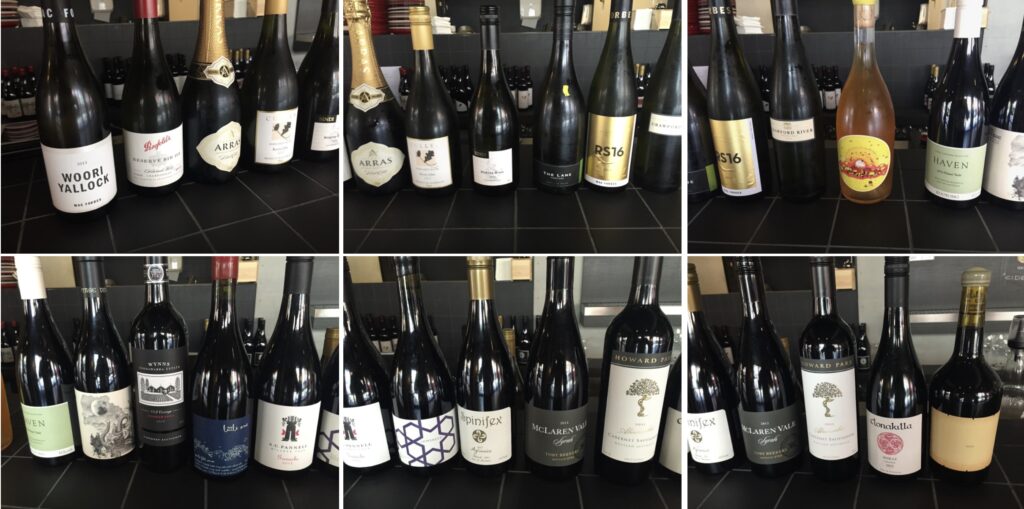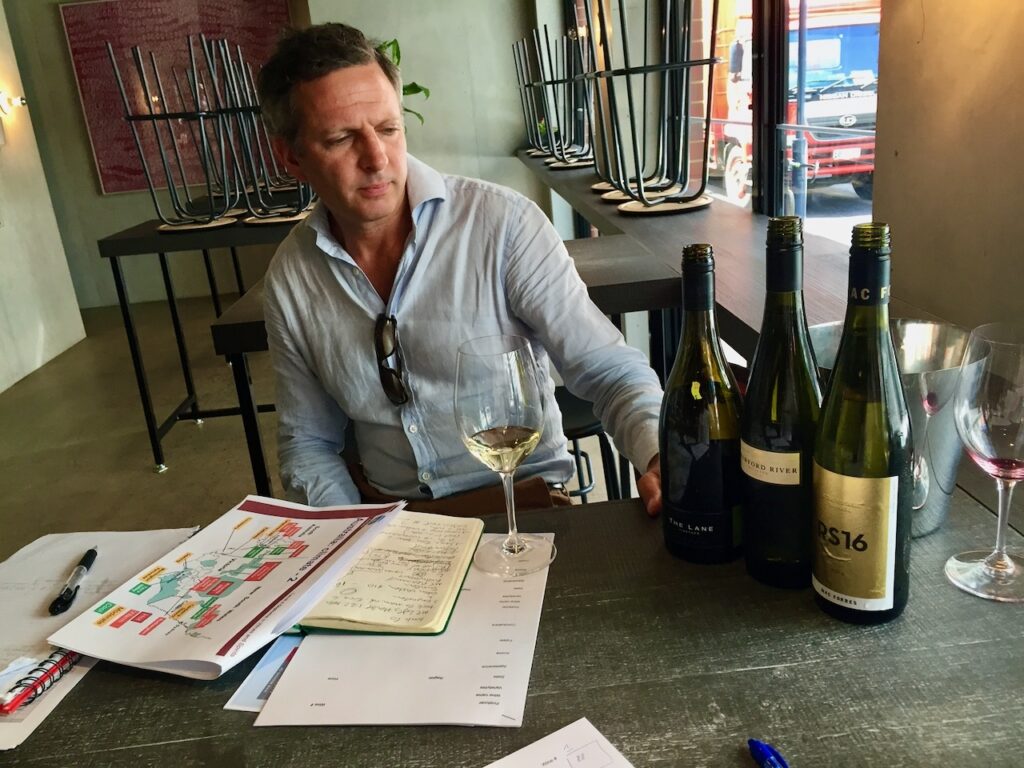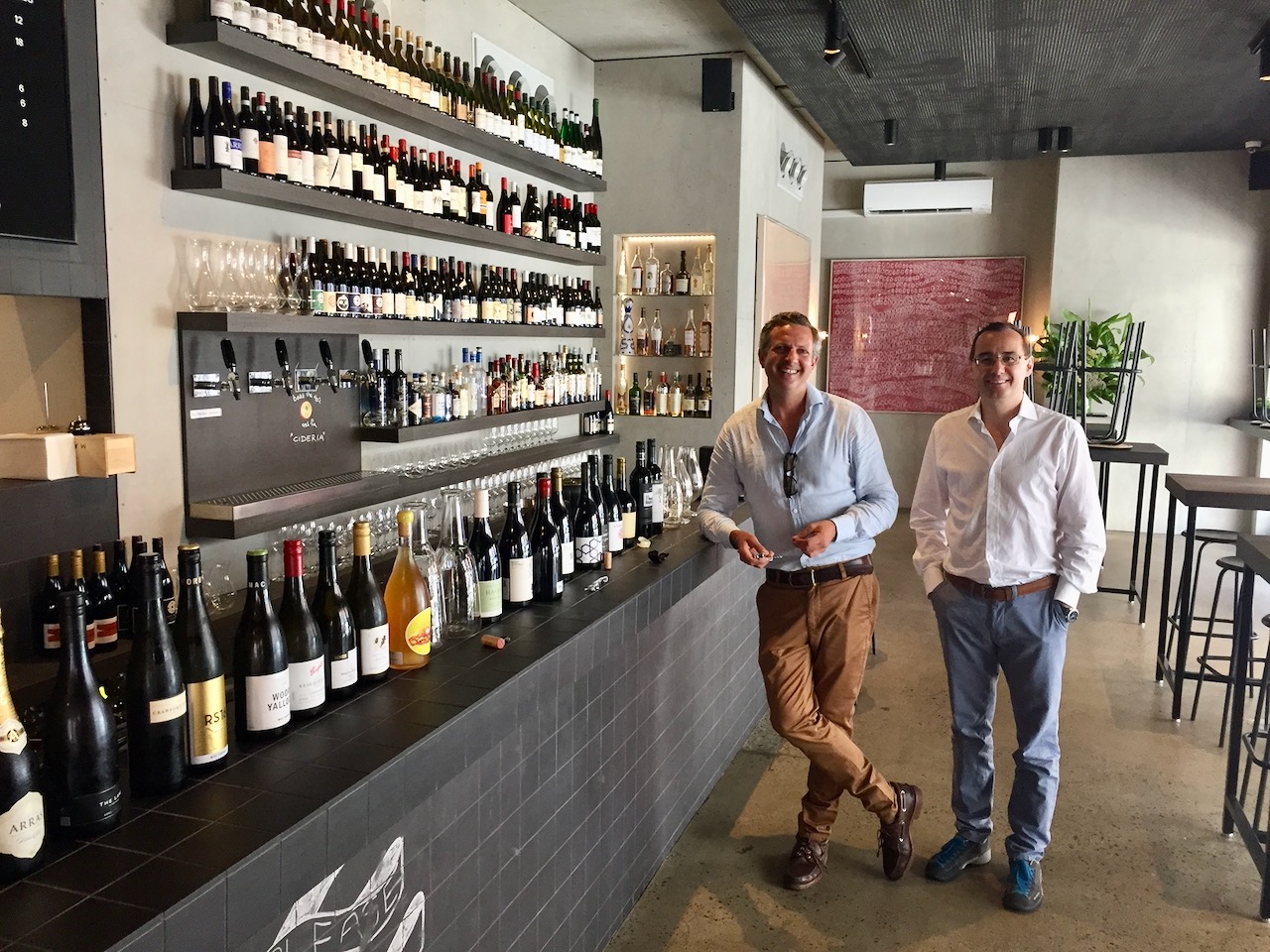A 2-day private tasting & tutorial session with Australian wine expert Tim Wildman, MW. The first day we did a “State of the Union” tasting and tutorial to understand where Australia stands today after the crisis which started in 2006. We deliberately focused on the top quality wines beyond Grange and Hill of Grace which we all know and like but are at USD 500+ now. More interesting is the question, what can Australia do in the 50-150 range. The second day we spend in Barossa visited established wineries and “movers & shakers” wine makers.
As it turns out Australia is in a reshuffling mode after a recent crisis stemming from over production, export issues due to strong AUD, full throttle Barossa Shiraz falling out of favor with consumers, tarnished image due to mass producers like Yellow Tail, etc. As it looks will come much stronger out at the other end of the tunnel.
Tim pointed to 10 important trends in Australia:
- Slimline Chardonnay: Away from the buttery to the more elegant, Burgundian or even Chablis style that goes better with food. Mod Oz Chardonnay are they called. This could be really big especially since white Burgundy recently had a persistent problem with premature oxidation (http://oxidised-burgs.wikispaces.com)
- Refining Shiraz: Same as above, away from the cliché of the heavy Barossa to more cooler climate versions
- 2011 Vintage effect: This cold and rainy vintage made many lighter wines. Consumers liked it and they are now here to stay
- Perfecting Pinot: While New Zealand is leading the way, Australia is now catching up. Regions around cooler Melbourne, especially the Mornington peninsula are to be watched
- Grenache Renaissance: more and more people recognize that Barossa and other areas are now too hot for Merlot/Cabernet and may be even Shiraz which, btw. is a northern Rhone and not Southern Rhone varietal. Now Grenache and other Chateauneuf varietals are on the rise in these places and it looks like they are fitting in really well.
- Semillon/Sauvignon blends: This typical white Bordeaux blend combination is tried more often with very promising results
- Sub-regionality: Sub-regions are becoming more confident and are looking for their unique style and varietal that suits them.
- Mediterranean varietals: With the recognition that Barossa et al are really hot places, wine makers are experimenting with Aglianico, Sangiovese, etc.
- Tasmania rising: Lots of investments have gone here recently. With global warming Tazi has entered the climate zone where cooler climate grapes (Pinot, Chardonnay, Riesling) can be made. To be watched
- Premiumization: Driven by Asian clientele famous producers are making ueber-expensive carve out wines.
Tasting Notes
Flight 1 – Sparkling
Fizz is usually a bit more fruity and less chalky and mineralic than Champagne. However, Tim noted that he recently attended a blind tasting in London where lots of attendees, even professionals, had a hard time telling the Aussie Sparkling apart from the Champagne.
NV House of Arras Brut Elite, 89 Points
Light yellow. Flowery and nutty nose. Palate a bit foamy. Quite fruity on the palate in a nice way, not as yeasty and chalky as Champagne. Medium length. Well done but not particularly long.
Flight 2 – Low oak whites
Non-Chardonnay Aussie white is on the rise. We discussed where Petrol notes in Riesling come from. Apparently it is the TDN chemical component that comes from sun exposure and hydric stress of Riesling. TDN gets into the grape and then develops in the bottle as the wine ages. In this flight we also discussed different types of acidity between Riesling (racy, slippery, laser, linear), Sauvignon Blanc (sharp, jiggered, tangy, stingy) and Chenin Blanc (broad, firm, tart)
2010 The Lane Vineyard Gathering, 93 Points
Light yellow. Expressive nose of herbs without being herbaceous, top note of fennel and dill. Medium bodied with very good fruity density yet elegance due to well integrated acidity. This wine could be a future star as well. Very dedicated team recently joined by one of the key wine makers of Henschke.
2013 Crawford River Riesling, 92 Points
Very light yellow. Nose of lime, white flowers, saline, not very fruity but rather delicate in the greenish spectrum, Mosel/Rheingau comes to mind. Palate is very dry, with soft and slippery acidity. This comes from the coldest region in Australia.
2013 Mac Forbes Riesling RS16, 92 Points
Medium light yellow. Nose of orange, citrus, gummy bear with a hint of tangerine. On the palate much sweeter and richer (medium bodied) than the first Riesling of the flight. This is more Alsace than Mosel in style.
Flight 3 – Chardonnay
The Oz Chardonnay revolution is coming from 1. Planting in cooler areas, 2. Earlier picking 3. Pressing out more phenolics 4. Wild yeast fermentation 5. Barrel fermentation (instead of 1 big steel tank, many barrels ferment differently giving more complexity) 6. Restrained use of oak 7. No malolactic fermentation (avoiding buttery notes)
2013 Mac Forbes Chardonnay Woori Yallock, 90 Points
Light yellow. Nose of apple, quince, saline, oyster shell, almost Chablis. Medium-light palate, not very oaky, pronounced acidity providing freshness, quite lean in style.
2013 Penfolds Chardonnay Reserve Bin 13A, 94 Points
Medium yellow. Discrete nose of gun flint, sulfuric notes with greener fruit, very delicate and elegant, some sea shells. Palate has solid acidity, followed by medium body, Pugliny-Montrachet style. Nice. This apparently wins gold medals in Aussie wine shows consistently. 94+
2013 Bindi Chardonnay Kostas Rind, 92 Points
Medium yellow. Closed nose, more yellow than green fruit, peachy and a bit riper, long finish, aromatic wine overall. Medium+ bodied with more alcohol than the two wines before, slightly more Burgundian with some oaky notes and sulfites.
2012 Cullen Wines Chardonnay Kevin John, 89 Points
Medium yellow. Toasty nose of citrus, flowers, vanilla and a bit of oak. This is full bodied with the acidity to support it but it is a bit stingy. Modern, things need ton integrate here. May be time will help. A famous Chard from a top producer, may be just not so much my style.

The highly educational line-up prepare by Tim Wildman MW
Flight 4 – Natural, artisanal wines
Once of the latest global wine movement seem to be natural wines. Different people are trying different things beyond the norms. We tried an “orange” wine here. A white that is fermented like a red (on the lees).
2012 Patrick Sullivan Breakfast Wine 90 Points
Orange color (not joke). Expressive nose of grenadine syrup with some orange peel, very pleasant aromas albeit not very vinous. On the palate a big contrast! This wine is very dry (but not drying) and a bit tannic and not sweet as the nose suggests, fresh and elegant. Apparently this comes from the skins of the white wine. Very unusual, interesting wine. I could see this going well with a cheese platter or cold cuts. How to rate this? Nose 92, Palate 88+ for me.
Flight 5 – “Alternative” varietals
More and more Australians are experimenting with different varietals than just the global blockbusters (Chard, CabSav, Merlot et al) with very promising results. The purpose of this flight was to check in on these efforts. In this flight we also discussed the meaning of “aromatic length”. There are 3 types of length. 1) In the nose, smelling. Aroma that keeps changing every time that you come back to the glass, never getting boring. 2) Aromatic persistency on the palate that does not fall apart quickly as you hold it in the mouth and 3) After taste length that stays via re-olfactory sensations, sometimes even after you moved on to the next wine.
2014 Gentle Folk Petit Verdot, 88 Points
Low intervention, artisanal wine making house style. This is a Petit Verdot, . Light purple. Distinctively spicy nose similar to an easy drinking Cote Rotie Syrah, black pepper, cloves. The body is light, with medium acidity more like a Pinot Noir. This brings in a third varietal in into this potpourri. The Pineau d’Aunis from Loire or Ardeche region, a varietal that has a Syrah nose and Pinot body.
2012 Kooyong Pinot Noir Haven, 94 Points
Medium-light garnet. Expressive, highly aromatic nose of berry, cherry, spices with some earth. On the palate this is earthy with fine tannins, structured more like a Chambertin than a Vosne, also the aromas are more in that direction. Very good length. Wow, this is a Pinot that can go places and is able challenge the NZ flagships in this part of the world.
2013 Burn Cottage Pinot Noir, 89 Points
We put this in as a pirate to compare the Aussie Pinot. Medium purple, very vibrant color, almost shiny. Nose of darker fruit with some toasty notes as well. On the palate this is quite light and aromatically not as long as I hoped for from the color and nose.
2012 Spinifex Aglianico, 90 Points
Medium garnet. Nose of distinctive cut hey notes with some yeast, fermenting aromas. May be this goes away with aeration, I don’t know. On the palate the aromas extend from herbal to berry and cherry, much more pleasant and above all, very long. The palate is medium bodied with excellent fruit and just about the right dryness at the end. Nose 88, palate 92
2012 S.C. Pannell Grenache, 94 Points
Medium garnet with purple core. Nose of gingerbread, cloves and cassis, licorice at the finish. Very fine palate with medium-strong but ripe tannins, excellent mid mouth feel, medium weight. Very good length.
Flight 6 – Shiraz
We looked at the new types of Shiraz, away from the “thick and fruity” Barossa style that made Australia famous but at times also tired many palates.
2012 Jamsheed Syrah Beechworth, 93 Points
Medium purple. Nose of green pepper, Negroni vermouth, dill, celery – in short lots of green stalks (fermented with full stalks). In the background there are dark fruit and some cherry. This is very complex but a bit of an acquired taste/smell. On the palate medium+ bodied with solid tannins and good body as well as freshness. Very interesting Aussie Shiraz, off the beaten track for sure
2013 Clonakilla Shiraz Viognier, 94 Points
Medium purple, not as thick as many Aussie Shiraz. Nose of dark berry, some green stalks, more Rhone than Barossa in style. Really nice and racy, lots of aroma, good drinkability, not as tiring as some of the South Australia bruisers. Medium bodied palate with pronounced but ripe tannins. Needs time, young, drink 2018 onwards. Medium+ length
2012 Toby Bekkers Syrah, 95 Points
Medium purple. Distinctively grassy nose, intermixed with dark fruit and Indian spices. On the palate this is unashamedly South Australian with full bodied mouth feel, strong tannins of good quality and acidity buffering the fruit. Very generous. Very good balance of all components fruit-alcohol-tannins-acidity. A discovery. Apparently this is one of the rising stars of McLaren Vale I was later taught.
2013 Sami-Odi Shiraz DW-OLD, 93 Points
Very interesting bottle (like a liqueur bottle) , very interesting label (yellow, almost no inscription on it). Very dark purple, blackish core. Intense nose of dark fruit, blackberry jam, licorice with the typical Barossa resin. Full bodied, very fruity but with good energy and freshness. This is a very thick Barossa wine but made in a vibrant style, nothing confected. 93-95, depending on your tolerance for mass.
Flight 7 – Cabernet Sauvignon
To conclude, two Cabernet Sauvignon from the leading regions Coonawarra and Margaret River
2008 Wynns Coonawarra Estate Cabernet Sauvignon, 92 Points
Medium purple. Nose of dark fruit, eucalyptus, earth, “crushed ants” as they say in Australia. Medium bodied with some gripping, a bit rustic tannins. This is not for the faint hearted, . But since it is already 7 years old I wonder if these tannins will every soften to a degree that they will be elegant, like Bordeaux 1986 style I am tempted to say.
2011 Howard Park Cabernet Sauvignon Abercrombie, 93 Points
Dark purple. Quite ripe nose, dark fruit, blackberry jam, brooding with a little minty note at the end. On the palate this is very dense, ripe and polished with much riper fruit than the Coonawarra sample next to it, strong but silky tannins at the end. Medium length.

Tim Wildman MW explaining Australia’s current wine landscape
Conclusion
Two excellent vinous days in South Australia. Thanks again to Tim Wildman MW, who reminded me how professional and knowledgeable the members of the exclusive circle of Masters of Wine really are.
Author: Christian Raubach, WSET III, FWS, WSG Champagne Master
February 2015

